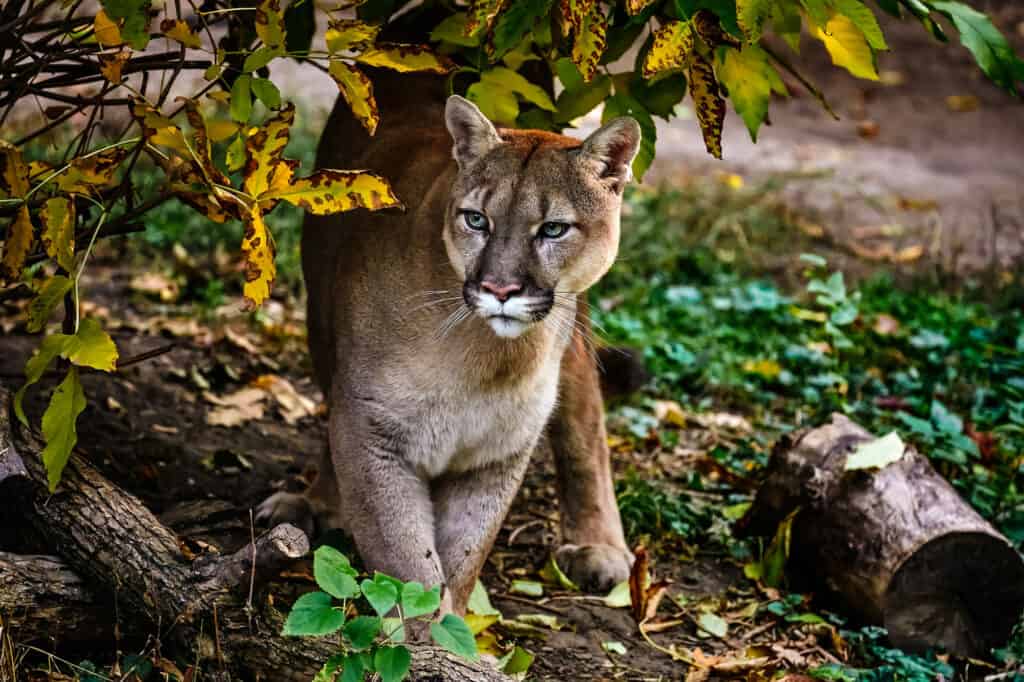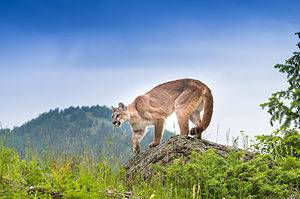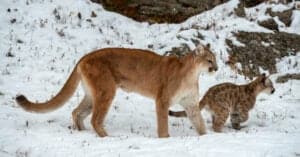Most animals hibernate during the winter months. Animals like bears, chipmunks, bats, hedgehogs, many insects, reptiles, and amphibians go into a state of slowed metabolism that helps them survive extreme periods of cold. It’s a sort of deep sleep during which the animal survives on a reserve of body fat instead of facing the blistering cold of winter to find scarce food.
While hibernation is one of the most common survival tactics of animals that live in cold climates, not all of them display this adaptation. Ever wondered how mountain lions survive the winter? Do mountain lions hibernate during winter like many other mammals? Read on to find out.
Do Mountain Lions Hibernate?

Mountain lions stay active throughout the year.
©Evgeniyqw/Shutterstock.com
Hibernation is one of the most interesting adaptations to survive extreme conditions. Animals that live in cold regions of the world with long winters survive the several weeks or months of winter by hibernating. During this period, the animal enters into a burrow or nest and “goes to sleep.” Their metabolism slows down significantly; their heartbeat slows down; they breathe slowly (or even stop breathing entirely for long periods), and their temperature drops.
However, mountain lions do not fall within this category of hibernating animals. Instead, they stay active throughout the year. Thanks to their own set of unique physiological adaptations, they can survive the cold winter months. Deer, rabbits, elks, and other smaller animals remain their primary food during this period. Mountain lions also eat fruits occasionally in addition to their carnivorous diet.
Ideally, the big cats live in a wide variety of habitats, including rainforests, grasslands, and mountains. Mountain lions belong to the Felinae family and are native to America, unlike other lion families. Pumas and cougars are the other common names given to mountain lions, depending on the region they are found. Native Americans call a mountain lion “puma,” while residents of California refer to the cat as “cougar.”
How Do Mountain Lions Survive the Winter?

Mountain lions have special anatomical and physiological features that help them thrive in harsh winter conditions.
©Evgeniyqw/Shutterstock.com
So if mountain lions do not hibernate, how do they survive the harsh winter months? Nature has been kind to the big cats. While hibernation seems like a neat adaptation, it is a pretty harsh one that takes its toll on the animal’s body. In fact, many hibernating animals die off if they use up their body’s fat reserve.
Mountain lions do not have to suffer through several months of suspended animation. Instead, they have special anatomical and physiological features that help them thrive in harsh winter conditions. For instance, pumas have thick body fur, which helps conserve body heat in cold seasons. In winter, mountain lions do not starve because they can still hunt and catch prey despite heavy snow. The following are some other winter adaptations that mountain lions rely on to survive without hibernating.
Special Internal Mechanism To Warm Its Blood
Like humans and other mammals, mountain lions are warm-blooded animals. This means they can maintain a body temperature higher than the rest of their environment (as against cold-blooded animals, whose body temperature depends on the surrounding temperature).
The cougar takes temperature regulation to a new level thanks to a unique mechanism for warming blood internally. The big cat’s neck and extremities have a network of blood vessels known as the “rete mirabile” or “miraculous net.”
The design of this network of blood vessels ensures that blood flowing to the big cat’s heart passes by vessels, carrying warm blood away from the heart. This unique network of blood vessels ensures that the heart never receives cold blood. So even if the head and limbs of the cougar are cold, the heart always gets warm blood, which keeps it from going into shock.
Thick Coats
During fall, mountain lions shed their fur. In place of this, they grow a thick double layer of fur that keeps them warm throughout winter. The winter coat also prevents moisture from reaching the underfur.
The fur stretches across the entire body and comes in gray, almost black, and tawny colors. Pumas groom their fur similarly to domestic cats, and the routine reduces their characteristic scent, which may attract other mountain lions or send away potential prey. The dull color scheme of the mountain lion’s coat also helps to conserve body heat.
Skilled Hunters
The absence of food during winter is one of the major reasons many animals hibernate. Animals that do not hibernate during winter must have other ways to keep up their energy reserve and prevent starvation.
Luckily, the physical characteristics of mountain lions make them suited to catching prey during the winter. Cougars have fantastic eyesight, which allows them to hunt any time of the day, from dusk to dawn. The snow coverings also make their prey more visible.
Another advantage the mountain lion has over other animals is the design of its paws. Unlike other animals, its paws allow it to move gracefully on snow. Its unique paws act like snowshoes, allowing the animal to travel on top of the snow instead of sinking in. So while its prey animals like elk and deer struggle to move around in the deep snow, the puma can move more easily.
Mountain lions also have powerful legs with impressive jumping abilities. While the forelimbs are flexible to manipulate captured prey, the hindlimbs are powerfully built to attain incredible speeds and heights. A mountain lion jumps higher than many other animals of similar size, a trait that comes in handy in prey capture.
What Do Mountain Lions Survive on in Winter?

Mountain lions use tracking and stalking to trace and find deer in winter.
©Scott E Read/Shutterstock.com
Although mountain lions primarily feed on deer, elks, and rabbits, they prefer deer in the winter. They need to retain as much energy as possible during cold months. These lions tend to give birth to their young ones towards the end of winter and early spring. Cougars are even more selective about their food when they have kittens.
Mountain lions use tracking and stalking to trace and find prey in winter. The deer finds it difficult to move on grounds heavily covered in snow. As it moves around, it leaves behind visible prints in the snow. Although mountain lions don’t have a strong sense of smell, scientists think they have adapted the ability to follow the track of their prey in the snow. Cougars will follow prey tracks in the snow for several miles until they catch up.
Do Mountain Lions Migrate During Winter?
Since pumas do not hibernate in winter, they spend a significant part of the season hunting. They are primarily nocturnal hunters with a need to make a major kill at least once a week.
On average, mountain lions consume an estimated 10 pounds of meat and 18 pounds of biomass daily. This implies that they must be in regions where their prey can be easily found.
Although the lions are not migratory, they may need to change location during winter in search of food. In some regions of the world, the migration pattern of mountain lions depends on that of their prey. For example, mountain lions in the Sierra Nevada Mountains of California have been observed to move with deer herds as they migrate during the seasons. In contrast, mountain lions in South America do not migrate with their primary prey.
It is also important to note that not all the preys migrate. Regardless of the change in season, some preys remain in their habitat. This non-migratory pattern is mainly observed in regions that do not experience extreme winter conditions. In this case, the mountain lion does not need to relocate.
Conclusion
Mountain lions are very formidable predators that stay active throughout the year. Although they do not hibernate during winter, cougars have several anatomical adaptations that help them survive through the winter. In extreme winter conditions, mountain lions take refuge among trees, dens, or caves for safety. But they still need to venture out occasionally to catch prey. Fortunately, these big cats have no trouble hunting for prey in terrains that other animals would have difficulty surviving.
Up Next:
- Mountain Lions Location: Where Do Mountain Lions Live?
- Are Mountain Lions Endangered?
- 11 Incredible Mountain Lion Facts
The photo featured at the top of this post is © Evgeniyqw/Shutterstock.com
Thank you for reading! Have some feedback for us? Contact the AZ Animals editorial team.






